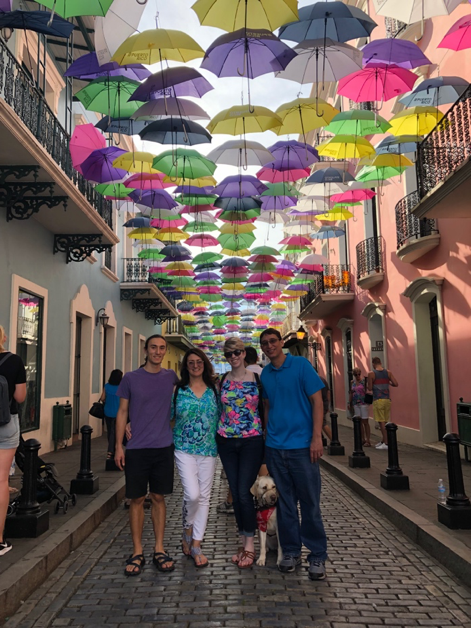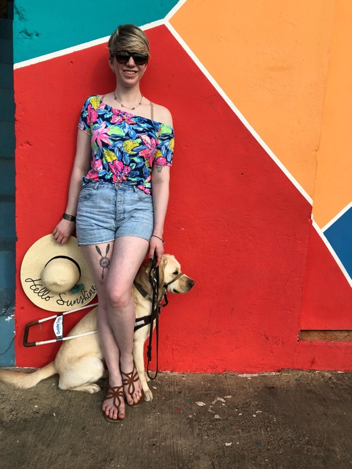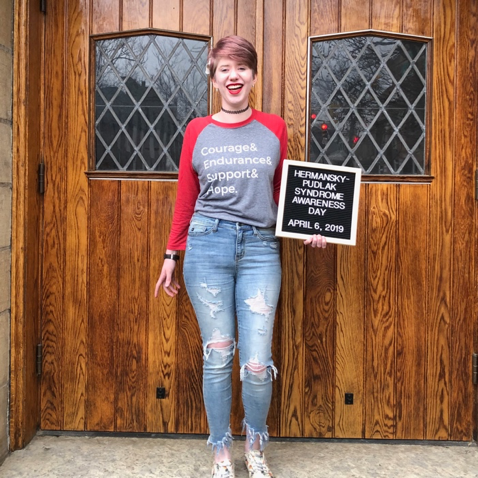Coping | Ostomy
Identity means to understand yourself, your priorities, and your defining traits. It’s a complex definition process we all have to go through since it’s just as multi-faceted as we are.

Throughout my life, my own identity has first and foremost been defined by my faith (Christianity). After that, my gender as a woman. Then as a person with a rare disease that has albinism and is legally blind, and last for my ethnicity as a Hispanic/Latina. This has largely been shaped by being raised in the Church; growing up in the Midwest surrounded by other Christians and little diversity; the daily challenges I face with physical disability and chronic illness; and being in the computer science field where women are scarce. These things alone aren’t my identity, but they all make up large parts of who I am.
Growing up, I’ve had a complicated relationship with my heritage, not always feeling part of it unless I was with my own nuclear family. After fifth grade, my brother and I both transferred to a primarily white private school. In seventh grade, my brother was bullied for being Hispanic; I never was. Visiting Puerto Rico was always exciting, but I always received the comments from well-meaning extended family pointing out my obvious lacking pigment. As I got older, strangers on the island were endlessly shocked that I could speak Spanish so well, but my brother was never questioned since he looked, well, brown. In both positive and negative ways, I was being questioned for not “looking the part.”
Since my brother had felt marginalized for looking different, he craved a connection with other Hispanics so in undergrad he seized the opportunity of joining many diverse organizations. I followed along and went to the same university, and he wanted to help lost little freshman Cass hit the ground running and meet some of his Hispanic friends. However, I’ll never forget meeting them: the pride in my brother’s voice showing me off, the confusion on their faces, the comparing glances between us, and the disbelieving, “Really?” that inevitably followed. My brother didn’t miss a beat, quipping, “Yeah, she’s so much taller than me, right?” even though he has a good two inches on me. Even though that broke the tension, I knew I wasn’t welcome. Despite that I was fully bilingual, which was more than quite a few of the people who “looked the part,” I was being rejected by the minority I was genetically part of because of my lacking pigment and obvious physical disability.
It was those first two or three years of undergrad that I was especially at a loss with how to relate to my heritage. I stopped trying in ethnic minority groups, joining a social sorority and becoming active in various disability and blindness-related advocacy groups instead. I began discovering a different part of my identity as a blind, disabled woman and even got a guide dog for my independence. Identifying with my heritage took a back burner in my life and only engaged in with my family. In those years, it was something I used to occasionally fool people in Two Truths and a Lie, and that other people used when they needed to interview a fluent Spanish-speaker for a Spanish class in college.
It hasn’t been until recently when I’ve been able to understand what it means to me. Last December my nuclear family and my brother and I’s partners went to Puerto Rico for two weeks, and for two weeks, my boyfriend was dependent on me to translate. It was then, introducing a foreigner to a place I had childhood memories of and speaking a language I wasn’t able to practice with anyone but my family, that I finally realized just how Puerto Rican I am, given growing up in Ohio. The language and culture all came with relative ease, and I truly appreciated my roots. My parents did an excellent job of teaching us the language and exposing us to culture, but society stunted me in engaging with it to better assimilate and grow where we were planted.
Identifying as a person of color is not something, I feel, describes me. I am a Hispanic person with albinism. However, I certainly can’t speak for every non-white person with albinism’s experience. My experience was a combination of many factors including my family dynamic, the lacking diversity around me growing up, my connection to the culture, being born in the U.S., and more. I do know that when I’ve expressed my own experience, I’ve gotten a lot of assent from many in the albinism community, so I know that I’m not alone.
My parents knew when I was born that I needed to protect my skin, wear sunglasses, couldn’t see very well, and could bruise very easily, given my diagnosis of a rare mutation of albinism called Hermansky-Pudlak Syndrome (HPS). Albinism itself involves lacking pigment in hair, skin, and eyes, which is why people with albinism often have bright white hair, extremely fair skin easily susceptible to sun damage, and light-colored eyes, but hues of it can even include more pigmented hair and skin as well. HPS is a little more complicated than that. We all also have a bleeding disorder characterized by deformed blood platelets that lack some core ingredients clotting blood. Additionally, depending on our subtype of HPS, we are more susceptible to developing autoimmune conditions like a Crohn’s-like intestinal disease or pulmonary fibrosis. Pulmonary fibrosis currently has no treatment. The only solution now is a lung transplant, which is almost like trading one illness for another to prevent organ rejection. However, there’s a lot of promising new research on the horizon, including prospects of gene therapy, but we’re constantly raising money for to find a cure. Despite this, my parents never coddled me, letting me be a rambunctious child who scraped her knees very often and still taught me to ride a bike. This doesn’t mean they neglected my needs, providing me with visual tools like magnifiers, forcing me to put on the sunscreen I hated, being more descriptive, and learning how to properly bandage my scraped-up knees.
Later on, as a freshman in high school, I wrote a research paper on the albinism crisis in sub-Saharan Africa (which is another story for another day). I discussed albinism and some forms of it as background, which had me reading articles related to HPS. I kept hitting the phrase, “About 20% of people with Hermansky-Pudlak Syndrome develop a Crohn’s-like intestinal disease characterized by granulomas in the large intestine, usually manifesting around age 15.” Having struggled in secret with some unknown GI issues the previous months, I asked my mother what this meant. We looked up Crohn’s disease and, not matching the typical symptoms, we shrugged it off. It was my pediatrician that referred us to see an NP at the local Children’s, and I was diagnosed with Crohn’s disease two days before my 15th birthday.
Since HPS is a rare disease, it only affects every 500,000 to 1,000,000 worldwide. However, due to a gene pool effect, HPS is extremely common in the tiny U.S. territory (colony) of Puerto Rico at only 1 in every 1,600. This fact was important for someone like me, a Puerto Rican baby born in the late 90’s who obviously had albinism, allowing me to be one of the small minority of HPSers to get diagnosed nearly at birth.

It’s no secret that there are tens of thousands of unique diseases with more being discovered daily, which makes it rare to find a physician who has even heard of HPS. What may be more detrimental, however, is if and how HPS is mentioned in medical texts. It usually gets one line of glory saying something like, “Extremely rare type of albinism found in Puerto Ricans.” This gets HPS known as the “Puerto Rican disease,” and this hasty generalization fails to account for nearly every other ethnicity, especially white Americans. Not only is it sometimes unclear if a white person has albinism or is “just fair,” or, “toe-headed,” but I’ve also heard countless non-Puerto Rican friends with HPS who get turned away from being tested for HPS for not being Puerto Rican. This is crucial; people need to know whether they have a bleeding disorder when treating injuries, before taking blood thinners like Ibuprofen, before having surgery, and other female-related risks. Even more important, though, is knowing if they’re predisposed for pulmonary fibrosis to be proactive, monitoring their lungs, avoiding smoking (which they should be doing anyway), and participating in research before it comes out of nowhere, as has unfortunately happened to many in the HPS community.
Being rare in this way is often exhausting. I’m grateful that getting diagnosed with HPS came so early in my life and getting misdiagnosed with different variants of GI issues only lasted eight months. I often feel like a minority in minorities in many ways: being less sighted than most but more sighted than many considered blind, not being “sick enough” to seem chronically ill but far too sick to put it out of my mind, and feeling almost misidentified within my own ethnicity.
Having HPS often involves a lot more than just medical concerns. For non-Puerto Ricans, many have to fight to be diagnosed. And yet for some Puerto Ricans such as myself, it involves some explanation when you don’t “look the part.” In Puerto Rico, the tropics give way to growing plantains, sort of equivalent to a potato. The plantain is a staple in local cuisine and culture. When cooking with plantains, abuelitas everywhere warn you that if you’re not careful, you’ll stain your hands or clothes, called la mancha de plátano, which is next to impossible to remove (I ruined a shirt from it once). Puerto Ricans also use this phrase to refer to themselves, saying that they have la mancha de plátano to imply that their heritage is a permanent mark they’re always proud to bear. Being able to identify more closely with my culture, I’m finally starting to see my very own, although colorless, mancha de plátano.

Cassandra Mendez is a 21-year-old student at the Ohio State University in Columbus, OH. She will graduate this summer with her bachelors in Computer Science and Engineering with a focus on Game Design and will start her career as a software engineer at J.P. Morgan Chase & Co. Cassandra was diagnosed with Hermansky-Pudlak Syndrome when she was seven months old and with Crohn’s-like colitis at age fifteen. After getting a permanent ileostomy at eighteen, Cassandra joined Girls With Guts and has since attended three retreats. In her spare time, Cassandra enjoys spending time with friends, playing video games, graphic design work, and listening to her record collection. Cassandra also has a guide dog named Romana, a sassy 4-year-old yellow lab from Guide Dogs for the Blind who has been her partner in crime for nearly two and a half years.

Notifications
I would love to speak with you Cassandra. It took a lot of "guts" to write this article…from one strong PR woman to another, I admire you for it.